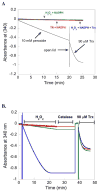Methaneseleninic acid is a substrate for truncated mammalian thioredoxin reductase: implications for the catalytic mechanism and redox signaling
- PMID: 21038895
- PMCID: PMC3018153
- DOI: 10.1021/bi101130t
Methaneseleninic acid is a substrate for truncated mammalian thioredoxin reductase: implications for the catalytic mechanism and redox signaling
Abstract
Mammalian thioredoxin reductase is a homodimeric pyridine nucleotide disulfide oxidoreductase that contains the rare amino acid selenocysteine (Sec) on a C-terminal extension. We previously have shown that a truncated version of mouse mitochondrial thioredoxin reductase missing this C-terminal tail will catalyze the reduction of a number of small molecules. Here we show that the truncated thioredoxin reductase will catalyze the reduction of methaneseleninic acid. This reduction is fast at pH 6.1 and is only 4-fold slower than that of the full-length enzyme containing Sec. This finding suggested to us that if the C-terminal Sec residue in the holoenzyme became oxidized to the seleninic acid form (Sec-SeO(2)(-)) that it would be quickly reduced back to an active state by enzymic thiols and further suggested to us that the enzyme would be very resistant to irreversible inactivation by oxidation. We tested this hypothesis by reducing the enzyme with NADPH and subjecting it to high concentrations of H(2)O(2) (up to 50 mM). The results show that the enzyme strongly resisted inactivation by 50 mM H(2)O(2). To determine the redox state of the C-terminal Sec residue, we attempted to inhibit the enzyme with dimedone. Dimedone alkylates protein sulfenic acid residues and presumably will alkylate selenenic acid (Sec-SeOH) residues as well. The enzyme was not inhibited by dimedone even when a 150-fold excess was added to the reaction mixture containing the enzyme and H(2)O(2). We also tested the ability of the truncated enzyme to resist inactivation by oxidation as well and found that it also was resistant to high concentrations of H(2)O(2). One assumption for the use of Sec in enzymes is that it is catalytically superior to the use of cysteine. We and others have previously suggested that there are reasons for the use of Sec in enzymes that are unrelated to the conversion of substrate to product. The data presented here support this assertion. The results also imply that the redox signaling function of the thioredoxin system can remain active under oxidative stress.
Figures






Similar articles
-
A mechanistic investigation of the C-terminal redox motif of thioredoxin reductase from Plasmodium falciparum.Biochemistry. 2014 Jan 28;53(3):601-9. doi: 10.1021/bi400931k. Epub 2014 Jan 17. Biochemistry. 2014. PMID: 24400600 Free PMC article.
-
No selenium required: reactions catalyzed by mammalian thioredoxin reductase that are independent of a selenocysteine residue.Biochemistry. 2009 Jul 7;48(26):6213-23. doi: 10.1021/bi802146w. Biochemistry. 2009. PMID: 19366212 Free PMC article.
-
Selenocysteine confers resistance to inactivation by oxidation in thioredoxin reductase: comparison of selenium and sulfur enzymes.Biochemistry. 2013 Aug 13;52(32):5472-81. doi: 10.1021/bi400462j. Epub 2013 Jul 31. Biochemistry. 2013. PMID: 23865454 Free PMC article.
-
Differing views of the role of selenium in thioredoxin reductase.Amino Acids. 2011 Jun;41(1):73-89. doi: 10.1007/s00726-010-0494-6. Epub 2010 Feb 21. Amino Acids. 2011. PMID: 20397034 Free PMC article. Review.
-
Antioxidant function of thioredoxin and glutaredoxin systems.Antioxid Redox Signal. 2000 Winter;2(4):811-20. doi: 10.1089/ars.2000.2.4-811. Antioxid Redox Signal. 2000. PMID: 11213485 Review.
Cited by
-
Contribution of selenocysteine to the peroxidase activity of selenoprotein S.Biochemistry. 2013 Aug 20;52(33):5514-6. doi: 10.1021/bi400741c. Epub 2013 Aug 12. Biochemistry. 2013. PMID: 23914919 Free PMC article.
-
Can dimedone be used to study selenoproteins? An investigation into the reactivity of dimedone toward oxidized forms of selenocysteine.Protein Sci. 2019 Jan;28(1):41-55. doi: 10.1002/pro.3390. Epub 2018 Mar 10. Protein Sci. 2019. PMID: 29451338 Free PMC article.
-
Two thioredoxin reductases, trxr-1 and trxr-2, have differential physiological roles in Caenorhabditis elegans.Mol Cells. 2012 Aug;34(2):209-18. doi: 10.1007/s10059-012-0155-6. Epub 2012 Jul 25. Mol Cells. 2012. PMID: 22836943 Free PMC article.
-
Why is mammalian thioredoxin reductase 1 so dependent upon the use of selenium?Biochemistry. 2014 Jan 28;53(3):554-65. doi: 10.1021/bi400651x. Epub 2014 Jan 15. Biochemistry. 2014. PMID: 24393022 Free PMC article.
-
Enhancement of auranofin-induced apoptosis in MCF-7 human breast cells by selenocystine, a synergistic inhibitor of thioredoxin reductase.PLoS One. 2013;8(1):e53945. doi: 10.1371/journal.pone.0053945. Epub 2013 Jan 14. PLoS One. 2013. PMID: 23342042 Free PMC article.
References
-
- Bock A, Forchhammer K, Heider J, Leinfelder W, Sawers G, Veprek B, Zinoni F. Selenocysteine: the 21st amino acid. Mol Microbiol. 1991;5:515–520. - PubMed
-
- Atkins JF, Gesteland RF. The twenty-first amino acid. Nature. 2000;407:463–465. - PubMed
-
- Sun QA, Wu Y, Zappacosta F, Jeang KT, Lee BJ, Hatfield DL, Gladyshev VN. Redox regulation of cell signaling by selenocysteine in mammalian thioredoxin reductases. J Biol Chem. 1999;274:24522–24530. - PubMed
-
- Carugo O, Cemazar M, Zahariev S, Hudáky I, Gáspári Z, Perczel A, Pongor S. Vicinal disulfide turns. Protein Eng. 2003;16:637–639. - PubMed
-
- Hudaky I, Gaspari Z, Carugo O, Cemazar M, Pongor S, Perczel A. Vicinal disulfide bridge conformers by experimental methods and by ab initio and DFT molecular computations. Proteins. 2004;55:152–68. - PubMed
Publication types
MeSH terms
Substances
Grants and funding
LinkOut - more resources
Full Text Sources

